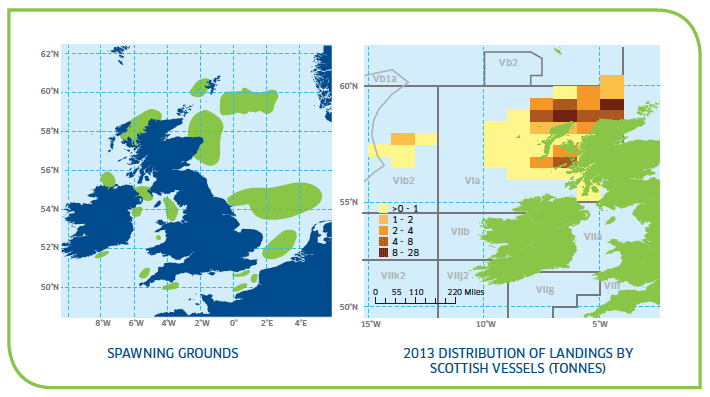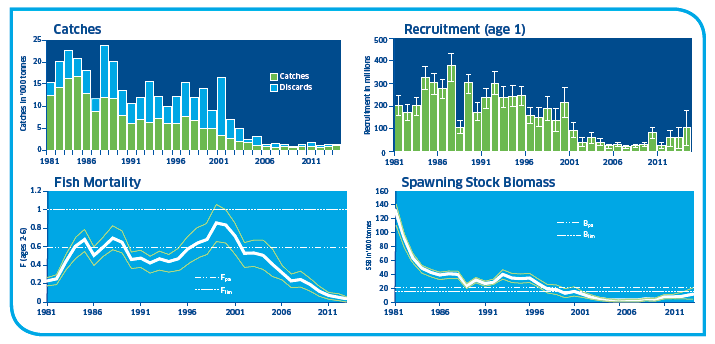Fish and Shellfish Stocks: 2015 Edition
Information on the state of fish and shellfish stocks of commercial importance to the Scottish fleet, inclduing Total Allowable Catches (TACs) for each stock.
Whiting Stocks - West of Scotland (VI, EC waters of Vb and international waters of XII and XIV)
Whiting ( Merlangius merlangus) has not been a particularly valuable species and is primarily taken as a bycatch with other species. They are mainly caught by trawlers using gear with mesh size between 80 mm and 120 mm. Discarding of this stock remains high, particularly within the Nephrops fishery.
2015 position: UK share 150 tonnes
Last Year: 167 tonnes
Landed into Scotland in 2013: 117 tonnes
Value for 2013: £108,000
Biology
Whiting is widely distributed throughout the west coast of Scotland, and high numbers of immature fish can be found in most sea lochs and inshore areas. The offshore stock is composed of older and larger fish which are recruited from the inshore shoals. Tagging experiments, and the use of fish parasites as markers, show that the whiting found to the south of 56°N and to the west of Ireland are separate from those in the Minches, the Clyde and the Irish Sea. The whiting population that overwinters in the Stanton Bank area moves to the Irish coast and the Clyde to spawn in spring. Some individuals may even move to the west of the Hebrides. There is no evidence to suggest movement between the west coast and the North Sea grounds.
Unlike some species, whiting do not form distinct spawning shoals, and both ripe and immature fish are often found together. As the latitude increases, spawning of whiting occurs progressively later. This is closely associated with temperature changes, but spawning activity generally peaks in springtime, just as sea temperatures begin to rise. On the west coast of Scotland whiting spawn between January and June. Within this period, the spawning season of an individual female lasts around fourteen weeks, during which time she releases many batches of eggs. At two years old most whiting are mature and able to spawn. By the time it reaches four years old, a single female fish of reasonable size can produce more than 400,000 eggs. Like many other fish, whiting spend their first few months of life in the upper water layers before moving to the seabed. Male and female whiting grow very quickly, reaching around 19 cm in their first year. After this the growth rate becomes much slower. There are large differences between the growth rates of individual fish, and a 30cm fish can be as young as one year or as old as six.
Whiting are active predators. Juvenile fish eat mainly crustaceans (shrimps and crabs) but as whiting grow, the amount of fish in their diet increases. The exact composition of the diet depends on the size of the fish, the area and the time of the year. Whiting is one of the main predators of other commercially important species of fish. Norway pout, sandeels, haddock, cod and even whiting themselves are frequently eaten. It has been estimated that each year the whiting population consumes several hundred thousand tonnes of these species.

ICES Advice on Management
Information Source: ICES advice 2014
http://www.ices.dk/sites/pub/Publication%20Reports/Advice/2014/2014/whg-scow.pdf
Quoted text in italics.

MSY and precautionary approach
Reference Points
| Type |
Value |
|
|---|---|---|
| MSY Approach |
MSY Btrigger |
Not defined |
| F MSY |
Not defined |
|
| Precautionary Approach |
Blim |
16,000t |
| Bpa |
22,000t |
|
| Flim |
1.0 |
|
| Fpa |
0.6 |
State of stock and advice
- Fishing mortality is uncertain. But estimates show it to have declined since 2005.
- The spawning-stock biomass has increased slightly since an all-time low in 2005, but remains very low compared to the historical estimates (and well below Blim)
- Fishing mortality and biomass cannot be determined with regard to either the Precautionary Approach or the transition to MSY Approach.
- ICES advises on the basis of the precautionary approach that catches in 2015 should be reduced to the lowest possible level - no directed fishery, and that effective technical measures should be implemented to reduce discards in the Nephrops ( TR2) fleet.
There is currently no specific management plan for this stock.
Given the low SSB and low recruitments in recent years, it is not possible to identify any non-zero catch which would be compatible with the precautionary approach. Catches should be reduced to the lowest possible level.
There are strong indications that management control is not effective in limiting the catch. The proportion of discarded fish is very high and appears to have increased in recent years. More than half of the annual catch weight consists of undersized or low-value whiting which are discarded. Approximately 80% of these discards come from the Nephrops ( TR2) fishery. Measures to reduce discards and to improve the exploitation pattern would be beneficial to the stock and to the fishery, particularly when there are indications that the 2009 and 2011 year classes are relatively strong compared to other recent recruitments.
The basis of this year's advice is the same as last year, the precautionary approach.
Management outcomes for 2015
In December 2014 meeting in Brussels, the Council of Ministers decided that the international Total Allowable Catch for west of Scotland (VI, EC waters of Vb and international waters of XII and XIV) whiting should be 263 tonnes. The UK quota for 2015 was set at 150 tonnes.
This quota decision was in line with the ICES advice to reduce catches. The west of Scotland, UK also committed to evaluation of its demersal fish selectivity measures and to exploring further selectivity developments in the light of findings. Furthermore, additional surveys were conducted in 2014 and are planned to 2015.
Contact
There is a problem
Thanks for your feedback